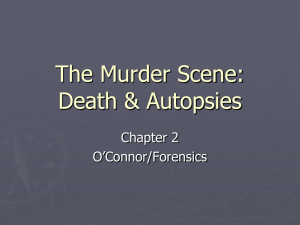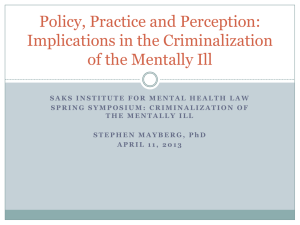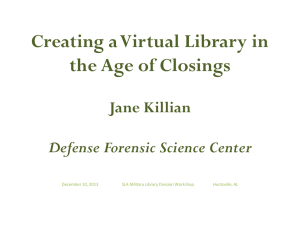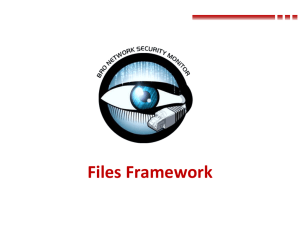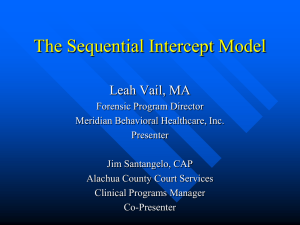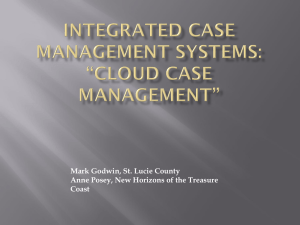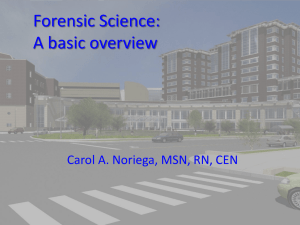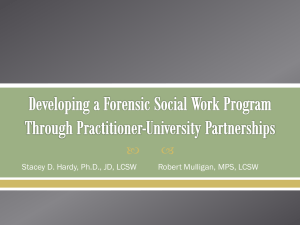Click here to learn more about the program and outcome data.
advertisement
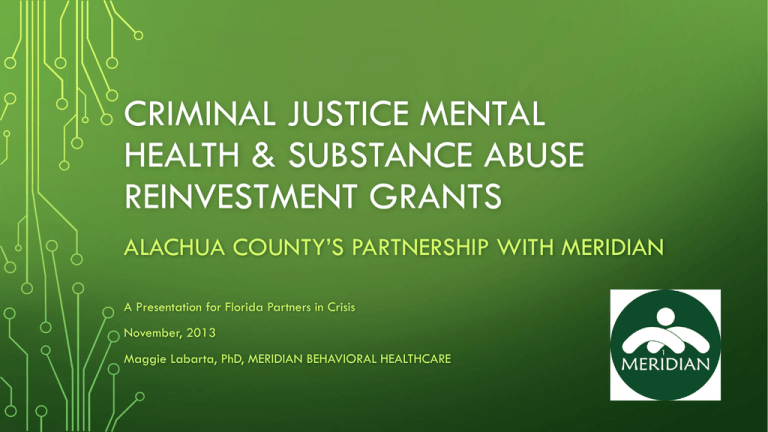
CRIMINAL JUSTICE MENTAL HEALTH & SUBSTANCE ABUSE REINVESTMENT GRANTS ALACHUA COUNTY’S PARTNERSHIP WITH MERIDIAN A Presentation for Florida Partners in Crisis November, 2013 Maggie Labarta, PhD, MERIDIAN BEHAVIORAL HEALTHCARE 1 ALACHUA COUNTY • Population of 251,417. • Capital of the Gator Nation, Gainesville is home to the University of Florida, with some 50,000 students • 874 square miles, Alachua County is a mix of urban and rural communities • Median household income of $41,373. According to the 2010 U.S. Census report, 24% of its residents live at or below the poverty level which is well above the State average of 15%. 2 MERIDIAN • Comprehensive behavioral healthcare center • Co-occurring enhanced services • Services from outreach and prevention to in-patient, residential, and long-term supported housing • Service area includes 12 North Central Florida Counties – 550,000 population • • • • • • • • • Two crisis stabilization units (50 beds) Residential treatment – mental health, substance use, co-occurring Pre-post partum residential treatment Medically assisted treatment for substance use disorders 9 outpatient clinics 3 collocated sites within primary care School-based services Mental Health First Aid © Part of the CIT Training Team • Provide treatment services to almost 14,000 clients a year, contact another 11,000 through prevention and outreach 3 JAIL CHARACTERISTICS • Rated capacity of 976 with a 15% classification factor . Between Dec. 2012 and May 2013 the average daily population was at a low of 855 in March and a high of 983 in December • The Department of Court Services interviews of all inmates prior to their first appearance. • 23% of adults were arrested for an alcohol violation while only 8% stated they had an alcohol problem; paradoxically, 7% were arrested for an illegal drug incident yet 14% selfreport a problem with drugs. • About 1.6% self report as having a mental health problem; however, 30.2% of all Jail inmates receive psychotropic medications while incarcerated in Alachua County. • Of the daily census, 57 individuals report being homeless . 4 FORENSIC SERVICES: MERIDIAN AND ALACHUA COUNTY PARTNERSHIP 1998 MH/SA Providers Law Enforcement Public Defender Public Safety Coordina-ting Council Courts (Judges & Staff) County Government (Elected & Staff) State’s Attorney 5 FORENSIC PROGRAMS • Largely concentrated in Alachua County • 1998 – County Committee identified MI/SA as reasons for growing jail • • population and agreed - That treatment was the correct thing to do - Partnership would be required 2000 – Mental Health Court established by Judge Jim Nilon 2003 – Crisis Intervention Team grant written – Felony Mental Health Court established Judge Martha Ann Lott – Community Based Competency Restoration program established 6 • 2005 – community partners visited Denver • CIT classes started • In-jail to community competency restoration funded by DCF • County created Mental Illness Workgroup (“MIWg”) to identify needed services and develop Strategic Plan for effective jail diversion system. 7 SEQUENTIAL INTERCEPT MODEL1 + COMMUNITY VISION = STRATEGIC PLAN Not available In place Partially in place 1 Facilitated by the USFFMHI CJMHSA Technical Assistance Center Post Booking Intercepts Coordinated screening and classification Forensic Specialists Pre-Booking Intercepts Crisis Intervention Teams Fully funded community based system of care Court/Jail Intercepts In-jail specialized treatment Therapeutic Courts (Misdemeanor, 916, Felony) Community-based Competency Restoration Services Forensic Specialist Team Forensic Diversion Team Vision: A community that no longer needs jails and courts to serve as a provider of mental health and addictions treatment Re-Entry Intercepts Forensic Residential Treatment Forensic Specialist Team Forensic Diversion Team Peer Specialists Post-Release Intercepts Specialized Probation Specialized, Supported Housing Fully funded community based system of care 8 • 2006 – MIWg report leads to funding for enhancing existing • • competency restoration program and creating a “Forensic Specialist Team” 2007 – County Commission created CJMHSAG Planning Committee • Chaired by member of Court or a County Commissioner • County Advisory Board charged with responding to grants and other funding opportunities • Awarded first 3-year $2million DCF CJMHSA Reinvestment ACT Implementation grant created treatment team to which most ill individuals could be referred, worked hand in hand with staff funded by DCF (competency restoration) and Forensic Specialist Team 2010 – Awarded expansion $1 million DCF CJMHSA Reinvestment ACT Expansion grant • Integrated the work of both teams to adapt to lowered funding • Expanded array of services through integration • Added trauma services and Moral Reconation Therapy 9 SPECIALIZED PROGRAMS: COUNTY, AND GRANT 1, GRANT 2 INTEGRATED THEM AND EXPANDED WHO WE SERVE Forensic Specialist Team • Outreach and Intervention • • • • • • • • Forensic Diversion Team • Based on ACT model • • • • Engagement Competency Restoration Referral Accessing benefits (SOAR) Monitoring • • • • Uses existing treatment resources Provides advocacy in Court Single point of accountability for court cases Self-contained team Engagement oriented Co-occurring enhanced Multidisciplinary • • Jail classification staff Counselor Peer specialist ARNP Treatment supports – housing vouchers Focus on high recidivists for both treatment and court systems 10 PROGRAM FOCUS • GOAL – Minimize jail time and increase participation in treatment • At booking • Post booking • Re-entry • METHOD • • • • • • Screen at booking First appearance evals Mental Health Court Competency restoration at jail and in community Diversion – VA, state hospital Treatment on re-entry 11 PROGRAM DESIGN • Phase I (Pre-engagement): Pre-treatment groups; motivational interviewing; program orientation/education; linkage/referral to community resources/programs • Phase II (Recovery Services): Starting treatment services; individual/group therapy; case management; medication management; drug testing; linkage/referral to community resources/programs • Phase III (Stabilization): Advanced level of self-sufficiency; individual/group therapy; case management; medication management; drug testing; linkage/referral to community resources/programs; increased usage of peer support services • Phase IV (Transition): Recommended for clients requiring minimal services to maintain stability; individual/group therapy; case management; medication management; drug testing ; linkage/referral to community resources/programs; increased usage of peer support services • Phase V (Aftercare): After graduation from treatment; assigned a peer specialist; case management; medication management; drug testing; linkage/referral to community resources/programs; structured curriculum (Wellness Recovery Action Plan) • • 12 STAFFING INITIAL • 8 Staff • Half funded by county, half CJMHSA Implementation Grant • Team make-up: • • • • • Team leader/program therapist (MA) 3 Forensic Specialists 2 Peer Specialists EXPANSION 9.2 Staff Counselors Forensic Specialist Forensic Outreach Specialist Peer Specialists ARNP Assessment Specialist Benefit Coordinator/Data Analyst Admission Coordinator/Screener 1.00 3.50 1.00 0.50 0.20 1.00 1.00 1.00 1 Jail Classification Specialist (ACJ employee) 1 part-time Benefits Coordinator (Court Services employee) 13 EVIDENCE BASED PRACTICES • Self-contained program • ACT “light” based on essential elements (funding would not support full ACT) • • • • Continuous engagement efforts Motivational enhancement Rapid access to medication Therapy within the program – Trauma Informed Care • Access to benefits for follow-up care - SOAR • Screening for Re-entry – GAIN checklist • Access, Plan, Identify & Coordinate (APIC) – coordination with community partners for successful re-entry • Moral Reconation Therapy • addresses needs of those with antisocial personality • Effectiveness data compiled and aggregated data by Meridian and Court staff 14 MORAL RECONATION THERAPY MRT is a 13 stage evidence-based cognitive behavioral, step by step treatment designed to enhance self-image, promote growth of a positive, productive identity, and facilitate the development of higher stages of moral reasoning. • Step 1 & 2 (Trust and Honesty): Disloyalty, the lowest moral and behavioral stage in which a person can function. • Step 3 (Acceptance): Opposition, starting to be somewhat honest. • Step 4 (Raising Awareness): Uncertainty, may lie, cheat and steal but uncertain if they should do so. • Step 5 & 6 (Healing Damaged Relationships and Helping Others): Injury, identifying that they have hurt others or themselves. 15 • Step 7 & 8 (Long-Term Goals and Identity and Short-Term Goals and Consistency): NonExistence, do not have a firm sense of identity and do not feel connected to the world. • Step 9 & 10 (Commitment to Change and Maintaining Positive Change): Danger, starting to commit to long-term goals. • Step 11 (Keeping Moral Commitments): Emergency, sense of urgency in completing goals. • Step 12 (Choosing Moral Goals): Normal, incorporating their identity into how they live their life. • Step 13 to 16 (Evaluate Relationships Between Inner Self and Personality): Grace, few reach this step where the person sees others as an extension of self. 16 OUTCOMES: VOLUME OF SERVICES • Referrals: 1406 to date, average 5055 per month • Admissions: accepted to date 432, average 12 per month roughly 25% • Average 15-20 pending referrals • Active in program 157 (215270/year), average 150-160, plus another 50 in state hospital • • • • 100% receive Case Management 25% receive treatment 23% receive Competency Restoration 77% of participants are in Felony Forensic Court or Mental Health Court. 17 WHO IS NOT ACCEPTED? 18 • 25% of active program participants were participating in treatment (not just CM) services provided by the Forensic Treatment Program in Phases II to V 30 25 20 Phase I • Phase I participants are those in Pending status post screening and pre engagement in Treatment • 44% (of program participants in treatment were in Phase II 15 Phase III Phase IV Phase V 10 Trauma Groups. • 59% (10 of 17) female participants in treatment 5 services were in Women’s Trauma Groups • Peer Specialists are providing follow up contact to 0 July 2013 Aug 2013 Sept 2013 participants who have been discharged 19 6 5 Step 1&2 4 Step 3 Step 4 Step 5&6 3 Step 7&8 Step 9&10 Step 11 2 Step 12 Step 13-16 1 0 July 2013 Aug 2013 Sept 2013 20 Moral Reconation: 5% of treatment participants OUTCOMES: EFFECTIVENESS • Days in the community: 91% for those not at state hospital • • • • Recovery • • • • 12% in jail 64% in community 24% at state hospitals 12 % in a Vocational Program 12 % Employed 5 % in School Adherence with medication: 82% Type of Discharge 30 25 20 15 Type of Discharge 74% 10 26% 5 0 Successful Unsuccessful The vast majority of unsuccessful discharges are for non-compliance 21 7 6 6 5 • Engagement works • 66% of unsuccessful discharges occur in 4 3 3 3 Successful Unsuccessful 3 2 2 1 1 0 Phases 1 or 2 0 Phase I 0 0 0 Phase II Phase III Phase IV Phase V or MRT 22 Arrests Arrests 3.5 3.5 Participation has long term effects 33 We see reductions in two year follow up for those who don’t succeed 2.5 2.5 Greatest impact is for those who stay with it 1.5 1.5 22 11 Graduates expanded benefit persists even after we refer them to traditional follow-up care 0.5 0.5 00 FYE2008 FYE2008 FYE2009 FYE2009 FYE2010 FYE2010 FYE2011 FYE2011 FYE2012 FYE2012 ARRESTS ARRESTSBY BYADMIT ADMITDATE DATE Pre-admit Pre-admit12 12month monthperiod period Post Postadmit admitmonths months1-12 1-12 Post Postadmit admitmonths months13-24 13-24 23 Jail Days 120 100 80 60 40 20 0 FYE2008 FYE2009 FYE2010 FYE2011 JAIL DAYS BY ADMIT DATE Pre-admit 12 month period Post admit months 1-12 FYE2012 24 Post admit months 13-24 COST • Forensic Diversion Team (Funding & Data for May 2011-June 2012) • • MIWG - $370,000 CJMHSAG • State - $250,000 • County Match - $167,000 • In-kind match (various sources) - $78,000 • • • Total annual funding: $865,000 Number served: 267 Average annual cost per person: $3,230 Post admission Jail Days 14,004 X $85/day = $ 1,190,340.00 Pre admission Jail Days 28,803 X $85/day = $ 2,448,255.00 PROGRAM IMPACT -14,799 NET COST AVERSION (IMPACT-COST) $ (1,257,915.00) $392,915 per year 25 LESSONS LEARNED • The CJMHSA Reinvestment Act funding has made a dramatic impact on the Planning, Implementation and Expansion of Jail Diversion services for persons with mental health and substance use disorders involved in the Alachua county Criminal justice system • Get community "buy in" by using the Sequential Intercept Model. • Utilize all community resources, bring them to the table. • Programs should have an Outreach component to allow flexibility. • Design the program to allow for flexibility with trends.... The program has to meet the needs of the clients, not the other way around. • Contingency funding is absolutely necessary 26 THE REAL REASON IT’S GREAT • Ms. B is a 33 year old female with a long history of mental illness and substance abuse. • • • • Formerly received services from FACT team ; dropped out two years ago. Arrested 4/7/13 for aggravated assault, with deadly weapon without intent to kill Not taking her medications, and experiencing severe psychotic symptoms She was immediately identified by the Forensic Liaison at the jail, who attempted to convince her to take her medications but she continued to refuse. • She then was evaluated, found Incompetent to Proceed, and meeting criteria for State Hospital. • Forensic Liaison succeeded in getting her to take her medications and provided competency restoration. • By the time Ms. Brown’s case was transferred to Felony Forensic Court, she was stabilized on her medications and competent. • The Forensic Program Director then advocated with the court that Ms. Brown did not need to go to the State Hospital and could be diverted to the community with supports in place. • Ms. Brown was released from jail on 6/20/13 to Forensic Treatment with her charges completely resolved. 27 QUESTIONS? Contact Leah Vail, Director, Forensic Services leah_vail@mbhci.org 28
